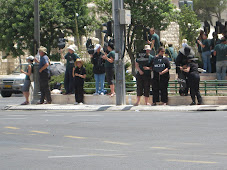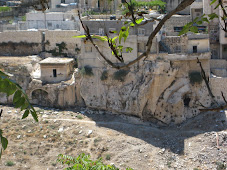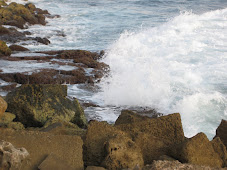I intended to write a post last night at the conclusion of Tisha B'Av, but we ended up having friends over who stayed late, and it was a wonderful evening, so I decided to go to bed and write something today. We have been trying to get together for weeks, it seems, and decided we would break the fast together. I didn't fast, and don't fast, because of medical issues. Rachel, experiencing her first Tisha B'Av in Israel which was very different from her experiences growing up (I will try to get her to write about that), fasted from sundown until the conclusion of Mincha services the next day, when the mourning period was over for her. Our friend made delicious lasagna which we all managed to polish off. I had run out a few hours earlier and bought a melon and some parve brownies, not thinking that it is almost impossible to make lasagna without cheese. But the brownies were actually really good, so no harm done there. So Erev Tisha B'Av began Monday at sundown. Rachel and I joined with many of her other classmates and other SOs in a garden area towards the back of the HUC grounds. It is a lovely area. We had Havdallah and a dessert reception there two Shabbats ago. There is an amazing view of the Old City walls, and sitting there for services where we remember the destruction of the 1st and 2nd Temples, where within those walls that we looked at during the services is the Western Wall, the only part of the 2nd Temple to survive, was a deeply moving experience. Most people sat on the ground, one of the customs of Tisha B'Av. Since we are all in mourning we are not supposed to be happy or comfortable. To save my back discomfort I opted to sit on a chair along with several others. The service began with the singing of "By the Rivers of Babylon" from Psalm 137. It went like this: By the waters, the waters of Babylon. We lay down and wept, and wept for thee Zion. We remember thee, we remember thee, remember thee, Zion." The melody was so beautiful and moving. A rabbinic student played guitar and a cantorial student led us in song, at one point being broken up in 3 groups, each group singing a different line. It really sounded a lot like an African-American spiritual. It went on for some time and then the service proceeded. I kind of hung out on the waters of Babylon for most of the service, meditating on the words and melody of this short yet powerful prayer. I kept glancing slightly to my right to see the Old City. When the service ended, a Rabbi at HUC who is also a professional tour guide and takes students regularly on guided tour, took us to the Old City. We walked and stopped right beside the perimeter wall and he gave us some information and taught us a song. I was too busy watching cats chasing each other and all but climbing the actual wall to pay much attention to the group. We then walked to visit the tomb of King David within the Old City. There were a lot of people there praying and reflecting.
The group then got to actually walk on the walls of the Old City which was really cool, proceeding towards the Kotel Plaza and Western Wall. From the time we walked from HUC to the time when we arrived at the Plaza there were throngs of all "types" of people -- secular Israelis, religious Israelis, ultra Orthodox, black-hats, reform, liberal and progressive Jews like us, large groups of high school and college aged kids on organized trips to Israel, etc., etc. The Kotel Plaza was PACKED -- it was amazing to see so many people in one place for one main reason, that reason being to mourn the loss of the 2nd Temple, although there were huge differences in how people felt about whether or not a 3rd Temple should be built.
So about that 3rd Temple.... Reform Jews use the word "temple," because they consider every one of their meeting places to be equivalent to, or a replacement for, The Temple. I will quote/summarize an article written by a Rabbi on www.kolel.org: The real question that Ezekiel's description of the rebuilt Temple prompts is, do we want the Third Temple rebuilt, and should we? Many of the prophets who lived after the destruction of King Solomon's Temple believed that the Temple would be rebuilt, and their words were consolation to the exiles. The return to Zion and the rebuilding of the Temple were often mentioned together, and while the former has come true in our lifetime, the latter has not. There are serious political and pragmatic difficulties with building a third (Jewish) temple on the site of the present Al Aksa Mosque and the Dome of the Rock, and most liberal Jews (and I would hazard a guess that even some Orthodox too) understand the rebuilding of the Temple metaphorically. But not everyone thinks this is just poetry. Undeterred by the physical and historical realities, today there exist (Jewish and Christian) zealous messianic groups (such as the Temple Mount Faithful in Jerusalem) that are actively preparing for the day (coming soon, they believe) when the Temple will be restored, and the Temple service, as described by the Torah and Ezekiel will be reinstituted. They are busy building the artifacts for the Temple so we'll be ready, and even though they are basing their efforts on the Torah's descriptions, there are technical terms whose meaning scholars do not understand, materials we do not have, and measurements that we are not sure of. (The fact that Ezekiel's regulations contradicts with the Torah's version is problematic, but a separate issue). And in case you think praying for the sacrifices is only for extremists, even your not so radical, average, moderate, modern Orthodox Jew prays for the restoration of the Temple every day. Conservative Jews read about the Temple and the sacrifices, but the newest Conservative prayerbook changes the Shabbat Musaf prayer to refer to the sacrifices as something in the past, not hoped for in the future. Only Reform and Reconstructionists have deleted these references from the prayerbook. But it is not only the denominations that draw these lines. According to the Rabbis, after the destruction of the Temple, prayer (avodah shebalev- the service of the heart) replaces the sacrifices. But the question is: does it permanently replace it (a la Maimonides) or is it a temporary substitute while we nostalgically remember the incense and the blood on the altar. Many rabbis use the 'gradual approach': the Israelites were accustomed to pagan practice and weren't yet sophisticated enough to understand abstract prayer so God instituted korbanot as a 'concession'. Some use this same argument, for example, to suggest that the laws of kashrut are really to wean us from meat, a kind of proto-vegetarianism. Leviticus is about sacrifices, but what we believe about the sacrifices and the Temple cuts to the core of our approach to Judaism. Since God doesn't change, and God's words don't change, some would like their Judaism to not change either. But history marches on, and hopefully our understanding matures. Either the earlier version of Judaism is/was perfect and shouldn't change, or it is an evolving, historical conversation between humanity and the Divine.
Okay, back to our Erev Tisha B'Av journey. After going through security we entered the Kotel Plaza. It was packed with all kinds of people from the groups I mentioned earlier, and throngs of others as well. I stayed towards the back of the Plaza and took pictures and video. I had no interest in fighting my way through the crowd and then trying to push past women to get to the actual wall. It sure is easier for men to pray there as their space is so much bigger (I pray that the separation will someday change). I'm also not the type of person who prays at the Wall because I'm supposed to and everyone else is doing it. I want a really spontaneous, grounding and spiritual experience when I pray at the Wall. I could see a difference in the demeanor of, for example, more secular Israelis and more religious Israelis. The more secular were sitting, leaning, talking and laughing while the more religious came to pray and left quickly, usually not talking or laughing while they walked with others. It was after 11pm when we left the Plaza and walked home, and the crowds seemed to be getting bigger. Apparently the ultra religious sometimes sleep at the wall.
The Rabbi/tour guide who led us throughout the evening told us many interesting things about the Kotel Plaza. It did not become segregated by sex until two years after the establishment of the State of Israel. Until that time, the area surrounding the Kotel was open and not "owned" by one particular brand of Jews. Today, the Western Wall is considered a synagogue and run by an ultra orthodox sect and has Torah scrolls on the men's side. The Conservative Movement went to the Supreme Court of Israel and won the right to establish an egalitarian section at Robinson's Arch off to the right of what we all think of when we think of the Wall. An interesting aside is that the Reform Movement refused to join the suit because we decided "all or nothing" -- either we all are allowed to pray together at the Kotel or not. It is against the law for a woman to wear a tallit at the Wall and is punishable by fines and 7 years in prison. The Rabbi/tour guide has been a part of several mixed sex services at the Plaza -- they were screamed at by the ultra religious incessantly -- the man reading from the Torah stopped at one point and touched the back of his head which was bleeding due to a thrown rock -- once they stopped praying the protesters completely lost interest and went back to their own praying. The Rabbi/tour guide envisions a "Million Ema March" where the Plaza and Wall are swamped with elderly Jewish women, challenging the police as they are arrested and sent to jail for 7 years!!!
Don't forget to subscribe to our blog so that you receive notice when we post new things. Also, check out the photos and videos on DropShot -- the link is on the blog -- that I took at the Kotel Plaza on Tisha B'Av.






.jpg)




No comments:
Post a Comment